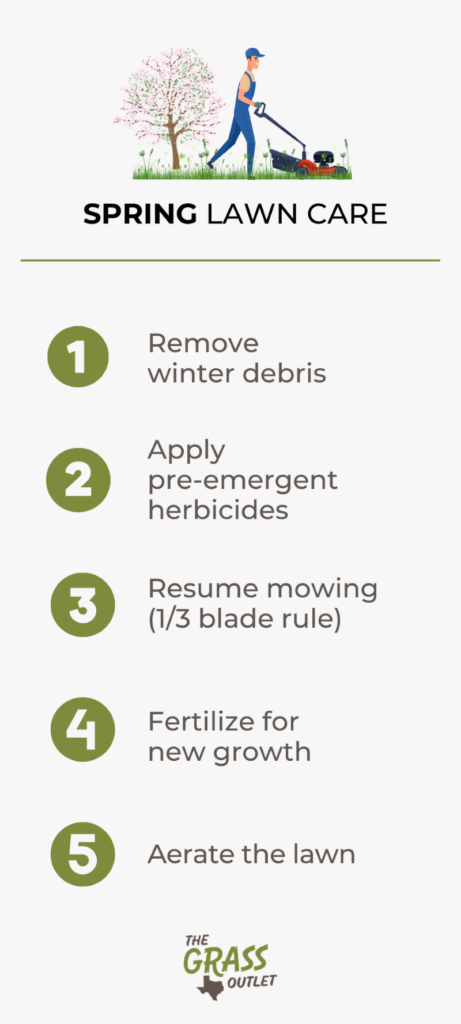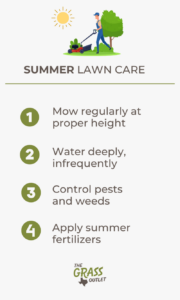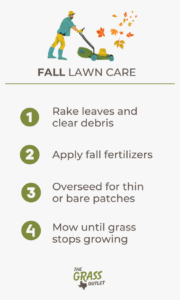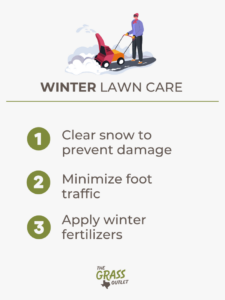Maintaining a green, healthy lawn requires dedication year-round. Like many garden plants, your lawn’s growth and behavior change with the seasons.
When searching for lawn care advice, you’ll find that timing is an important task. Proper timing aligns with nature and supports the natural growth cycles of local grasses. Here, we provide an overview of seasonal lawn care tips to help your lawn look its best throughout the year.
Spring Lawn Care

Your lawn may suffer during winter, but spring is perfect for a fresh awakening. Start your lawn care routine early in spring, but don’t rush. Ensure the ground is no longer frozen, the surface is firm, and the grass is green and starting to grow. If you start too early, it can cause more damage than good.
Spring encourages cool-season grasses to grow. Warm-season grasses like Bermudagrass and Zoysia are just ending winter dormancy. Spring lawn care is essential to prepare your yard for the growing season. Put the spring into action, preparing your lawn for the growing season.
Here are some essential steps and spring lawn care tips to follow before the season peaks.
Remove any debris accumulated over the winter
Start by cleaning any debris that has accumulated over the winter, such as twigs, leaves, and excessive dead grass, to improve air circulation and prevent mold. Remove weeds, too, ensuring you pull out the entire root.
Apply pre-emergent herbicides to prevent weeds
It disrupts their growth processes by stopping cell division or hindering root and shoot development. Use herbicides like crabgrass preventers before weed seeds germinate. The best time to do this is when soil temperatures reach around 55 degrees Fahrenheit.
Resume regular mowing, following the 1/3 blade rule
As the grass grows in spring, begin regular mowing to encourage growth and deter weeds. Wait until temperatures exceed 40 degrees Fahrenheit while the grass should dry. Never cut more than a third of its length. The ⅓ blade rule says not to cut any more than the top one-third of the grass blades. So, for three-inch grass, you want to mow when it grows to approximately 4.5 inches tall.
Fertilize to boost new growth
Spring fertilization is crucial because it supplies essential nutrients to plants as they enter their active growth phase after winter dormancy. This nutrient boost supports healthy foliage and root development, producing more robust, resilient plants. In addition, spring fertilization helps plants recover if any nutrient deficiencies may have developed over the winter.
Conducting soil tests in the spring may be beneficial to identify nutrient deficiencies, soil pH irregularities, or other soil health issues.
Aerate your lawn
Aeration opens up the soil, stimulating root development, especially when followed by balanced fertilization. Core aeration also alleviates soil compaction in older and high-traffic lawns.
Summer Lawn Survival Guide: Keep Your Lawn Thriving

We love spending summer in our garden and relaxing on a lush green lawn. However, summer can be the most stressful time for your lawn.
High temperatures and low rainfall cause cool-season grasses to slow down or dormant in extreme heat or drought, while warm-season grasses thrive and thrive. To support your grass, follow these summer lawn care tasks:
Mow regularly and maintain proper mowing height
Mow your lawn at least once a week, keeping the grass height at about 1 inch. Collect and compost all clippings, but avoid cutting too short as it encourages weeds and moss. Reduce mowing during hot, dry weather and let your grass grow longer. Raise your mowing height by 1 to 1.5 inches in summer to help shade grass roots, reduce evaporation, and encourage more profound root growth.
Use sharp blades. Dull blades can tear and shred the grass, undermining your summer lawn care efforts.
Water deeply and infrequently to encourage deep roots
Watering is one of the best maintenance tasks for your lawn during the summer. Water early in the morning or late evening to allow moisture to soak in rather than evaporate. Avoid light sprinkling every day since it may lead to shallow roots. Instead, give your lawn a good soaking once or twice a week.
Water deeply and infrequently. Well-maintained lawns with solid root systems better withstand and recover from dry periods. Aim for water to reach 4–6 inches deep. Test this by pushing a screwdriver into the soil; if you meet resistance, water more. Avoid watering right after rain.
Proactively control pests and weeds
Treat turf pests like newly hatched grubs while small and close to the surface. Effective treatment can stop the damage and prevent new pest generations.
Monitor your lawn for signs of insects, pests, and diseases, addressing any issues quickly.
Bald spots make your lawn more susceptible to summer heat. To prevent them, mow at or near the highest setting on your mower and avoid stepping on wet grass.
Traffic is more frequent during the summer months since we all like spending time outside, especially if we have pets. However, they can damage your lawn, so clean up after them immediately and flush away urine spots.
Apply summer fertilizers to promote strong growth
Use organic-based fertilizers during early to mid-summer. These are safe in hot weather compared to many synthetic fertilizers, which can burn your lawn due to their high salt content.
Feed your lawn with a slow-release fertilizer every 6 to 8 weeks. It helps keep your lawn healthy despite pests or drought. Fertilizing warm-season grasses like Bermuda and Zoysia in early summer is ideal. Standard in the Southeast, these grasses thrive at around 70 degrees Fahrenheit. Applying fertilizer during this time helps them grow thick and healthy. Fertilize those grasses every four to eight weeks during their active growth.
However, fertilizing too much can burn your lawn, so be cautious during the hottest months. Follow the manufacturer’s instructions for application to ensure your lawn stays healthy and resilient.
Fall Lawn Care

With cooler temperatures and falling autumn leaves, cool-season lawn grasses enter their most active growth period, while warm-season grasses begin to go dormant.
The following tips can help you maintain your lawn over the fall and achieve a beautiful lawn next year:
Rake leaves and clear debris
Rake fallen leaves so grasses get plenty of sunlight and air. Leaves block light and trap moisture, which can harm the turf underneath. Remove leaves regularly, even after trees are bare, to prevent grass from dying under the soggy, decaying layer.
Apply fall fertilizers to prepare for winter
Fertilizing in the fall helps the lawn develop a more robust root system before winter. The right fall fertilizer provides the necessary nitrogen and other nutrients without promoting rapid growth. This results in denser growth and a quicker green-up in the spring, which helps to discourage weeds.
The best time to apply fertilizer is in October and November, before Thanksgiving when the soil is moist, and temperatures are moderate. Avoid over-fertilizing to ensure you are strengthening the roots rather than producing excess thatch and new growth.
A soil test will help determine the exact nutrient requirements of your lawn.
Overseed to repair any thin or bare patches
Fall is ideal for germination and establishment of cool-season lawn grasses. When it comes to warm-season lawns, overseed them as they turn brown and go dormant. Overseeding fills in thin areas, spots missed by sprinklers, and areas damaged by disease or insects. It also introduces new drought and disease-resistant varieties to older lawns.
Fall is the ideal time to overseed because the ground remains warm, but the sun is not as intense during the day. In addition, moisture is more abundant while nights are cool.
The optimal time for overseeding is in September and October before the frost arrives mid-October. For small areas, scatter the seed by hand, and for larger ones, use handheld rotary or drop spreaders. Seed germination improves after lawn aeration, as the seeds are protected in the core holes. Cover the seed with a light top dressing if desired and rinse. Keep the seed evenly moist for 21 days or more with short watering sessions twice or thrice daily.
Keep mowing until the grass stops growing
Grass grows until the first frost and needs regular cutting. To do this during the fall, lower the height of your lawn mower to its standard-setting (usually about 3 inches). Cutting your lawn slightly shorter in autumn can help prevent matting under leaves.
However, avoid cutting it too short, as this can weaken the root system and reduce the lawn’s ability to withstand winter conditions. Regular mowing also chops up leaves, leaving behind soil-enhancing mulch.
Winter Lawn Care: Protect and Maintain Your Lawn

During winter, cool-season northern lawns are often covered in snow, while warm-season grasses remain dormant and brown. Southern lawns overseeded with cool-season grass need regular maintenance throughout winter.
Although winter requires fewer lawn care tasks, proper maintenance is crucial to prepare and ensure your lawn is ready for new growth. Use the winter months to plan and prepare for the upcoming spring season.
Clear heavy snow accumulations to prevent damage
If it snows, avoid shoveling snow onto the lawn or creating piles that force people to walk on the grass. At the end of winter, break up ice piles and spread the snow around to help it melt faster.
As winter turns to spring, new grass growth can be easily damaged by the pressure from feet or piled snow. Additionally, snow piles take longer to melt and can block the grass from receiving early spring sunlight, delaying the grass from turning green and starting to grow.
Minimize foot traffic
Keep foot traffic to a minimum to avoid compacting the soil and damaging the lawn. Be sure to minimize foot traffic on your lawn, as too much walking on snow or ice-covered grass can cause damage. The grass is more brittle when frozen and prone to breaking. If possible, direct foot traffic along a path around your lawn rather than directly across it.
Apply winter fertilizers
Before the first snow, aerate your lawn to allow roots to receive nutrients and oxygen. After aeration, apply a winter fertilizer to help the grass store nutrients for healthy spring growth. Winter fertilization is essential for maintaining lawn health through the cold season. As winter ends, be aware of snow mold, a fungus that can develop in wet, cold conditions. Treat snow mold with particular fungicides and seeding strategies.
Final Thoughts
Beautiful, healthy grass requires special attention in every season. Remember, your grass is alive year-round: even when dormant and not growing taller, the roots still need food, nutrients, water, and oxygen, and the lawn requires care and protection.
Neglecting proper care, preparation, or planning can result in an unsightly, yellowing, or overgrown lawn.
Developing and following a well-planned schedule can reduce the amount of work required. This approach ensures your lawn remains healthy, thriving, and vibrant through all seasons and years.


